Artprojects
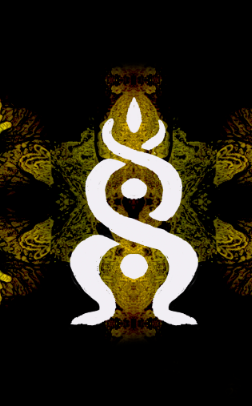
The Space Between Us
Inner Dimensions is an immersive video installation. It is about exploring our bodies in motion, our movement through the world, and how we move together through the space between us to weave a larger tapestry of connection. Our movements weave a larger tapestry of being, we are individuals and part of a whole.
Dancing between union and separation: The installation itself has been configured so that the interactive audiovisual composition evolves from individual to collective movements, where the audience is invited to move around an interactive area of 4×4 m. The installed motion sensors retrieve data sets of movements that are interpreted and visualized in different formats, starting from black and white visual versions of bodies in motion and developing into a more complex set of visual patterns influenced by what happens in the interactive area.
The Space Between Us
Shrine of life
Projected by: Cesarine Lafontant, Elizabeth Ricachi, Swaeny Nina Kersaan
Shrine of life is an anthropomorphic act of aknowleding Gaia.
rsonification of life on Earth. Her shrine is a method and a place to experience the unmeasurable interconne , together.
of the world of nature, and the world is part of us.
methods/language might be artificial, but our senses are not. What do we feel when we allow our feet to sin grass? Can we reconnect from an internal sea
Shrine of life
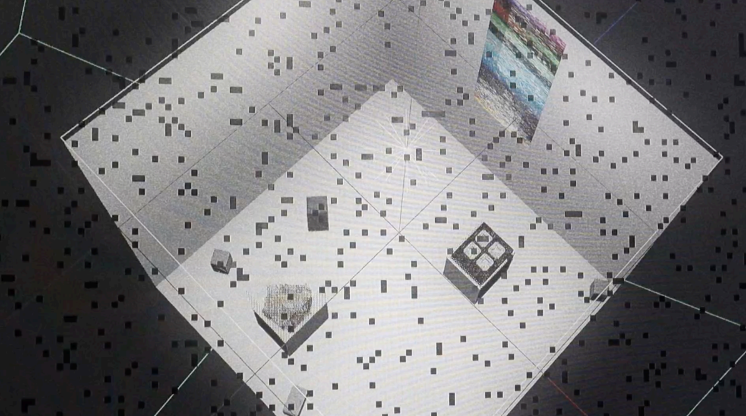
‘Assemblies’
Projected by Ryan Cherevaty, Rachel Heavey, Gerard Valls Montaño
‘Assemblies’ is a relational installation that explores human intervention and habitation on earth by encountering this
phenomenon from differing perspectives. Inspired by ‘archipelagic thinking’ (Édouard Glissant), ‘Assemblies’ explores
sustainable, ecologically, and socially informed urban planning and housing construction, and broader considerations
about how space is designed, experienced, shared and lived. Through creating an archipelago of three installations
exploring urban design, ‘Assemblies’ offers an investigation into encountering infrastructure, the built environment and
public and private space through a construct outside of the human perception of time.
Assemblies
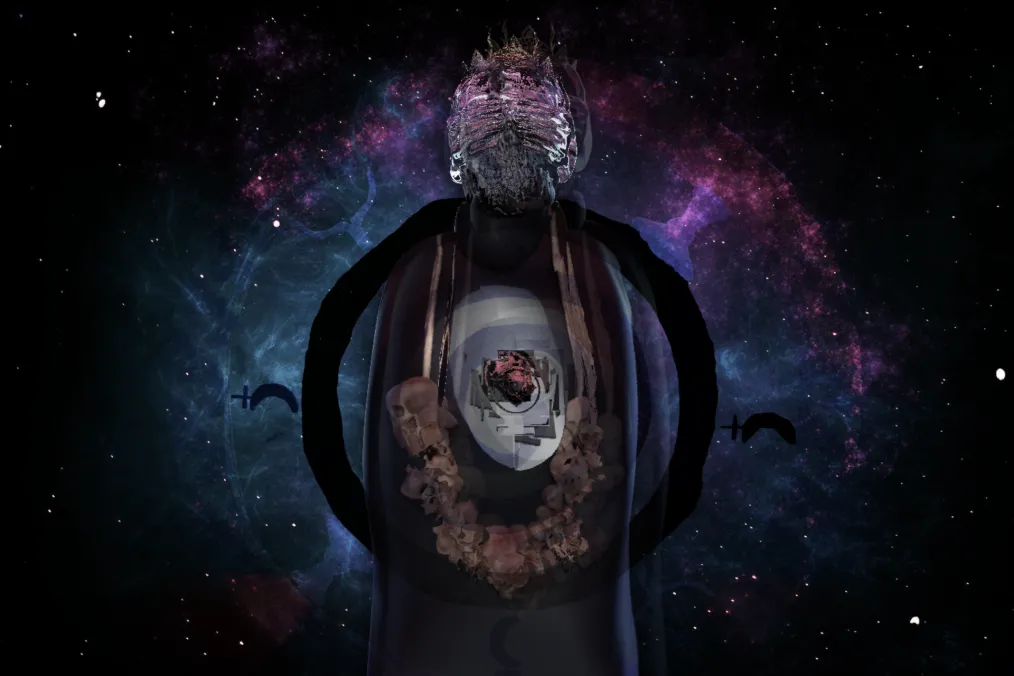
SIGIL
project by:
Juan Cabrera, Commonolithic, İrem Çoban, Isidro Escoda, Niall Hill, Francisco Macía Varela, Rafa Roeder
SiGiL is an experiment in digital transcendence. Using mixed reality; high-definition scanning; and a shared metaverse approach, it seeks a gateway between physical reality and the world beyond. An embodied journey into symbols and images at the root of the psyche; it extends the experience of sacred spaces to new digital dimensions.
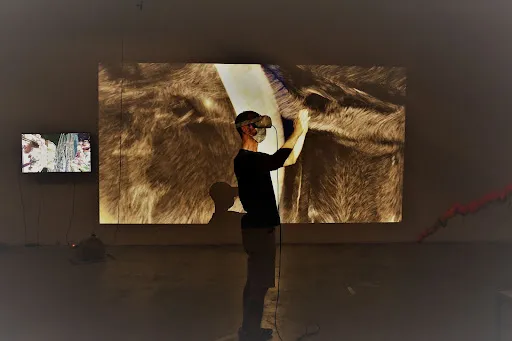
CILIA
project by:
Mohsen Hazrati, Daniel Cabanzo, Sara Tirelli.
It is a site-specific interactive installation 6Dof that immerses the user in a flow of perceptual mutation. From the 3D scanning of the Espronceda Gallery, Cilia developed space as a form of all external phenomena, under which only intuition is possible.
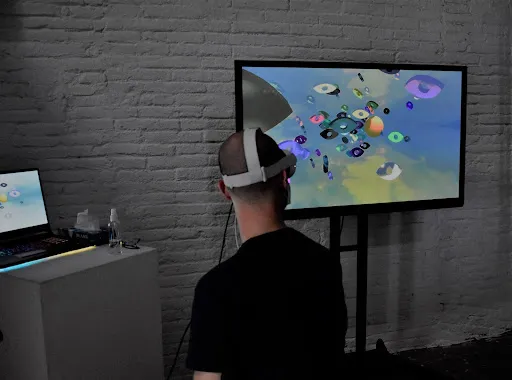
ALGORYTHMIC
project by:
Alicia Renee Ball, Onur Topal-Sümer, Rich Johnson
ALGORYTHMIC is the initial experimental phase of an interactive immersive interpretation installation through XR technologies, sound, synaesthetic and kinesthetic design. The work explores patterns of collective behavior, swarms of murmurs of various organisms, situations, and spatial conditions through particle simulations, manipulation, and control over the user experience in an environment that simultaneously produces immersive interactivity.
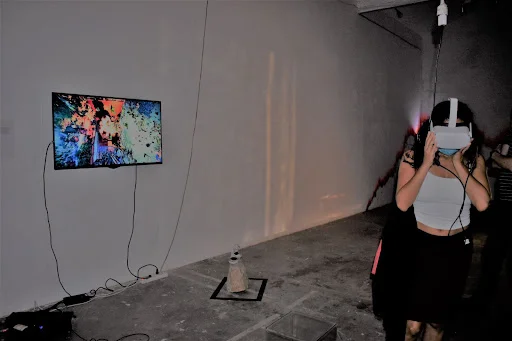
THEATRE OF INCONVENIENCES
project by:
Anirudhan Iyengar, Nuño de la Serna, Dominic Schwab, Helvijs Savickis, Julia
Obleitner, Mathieu Preux .
The theater of inconvenience explores the urban landscape of Barcelona and its everyday scenes in a psychogeographical virtual reality environment. It is an immersive experience observing the complex space. of Barcelona, identifying, narrating and rewriting fragments of the urban fabric. The city is a stage already prepared for encounters, actors, actions, surprise scenes and distorted visions. Urban elements together with everyday objects merge into a new space of imaginative conflict, consumption and inconvenience. The pseudo-arrangement of 3D scanning fragments of the city create dramatic narratives to perceive different timelines simultaneously; the city as an actor and the city as a stage.
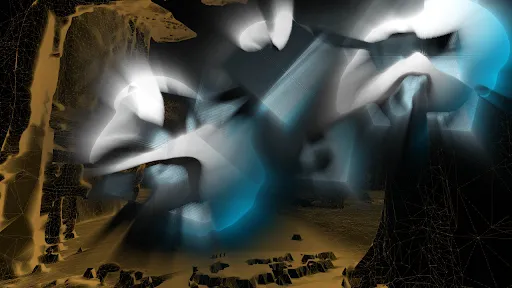
ENTARIUM
project by:
Daniel Cabanzo, Anna Bacheva, Emanuele Dainotti, Mathieu Preux
Collaboration:
Racelar Ho, Rich Johnson, Corinne Linder.
This work of art is directed directly by the spatiotemporal information of a physical context and its components. Like a giant mirror, the installation has its own autonomous memory and together they propose a retrospective and real-time representation of reality. Entarium is inspired and created in the space in which it lives. It moves and evolves as a living organism, questioning our relationship with the environment and inventing a new hybrid territory to be observed.
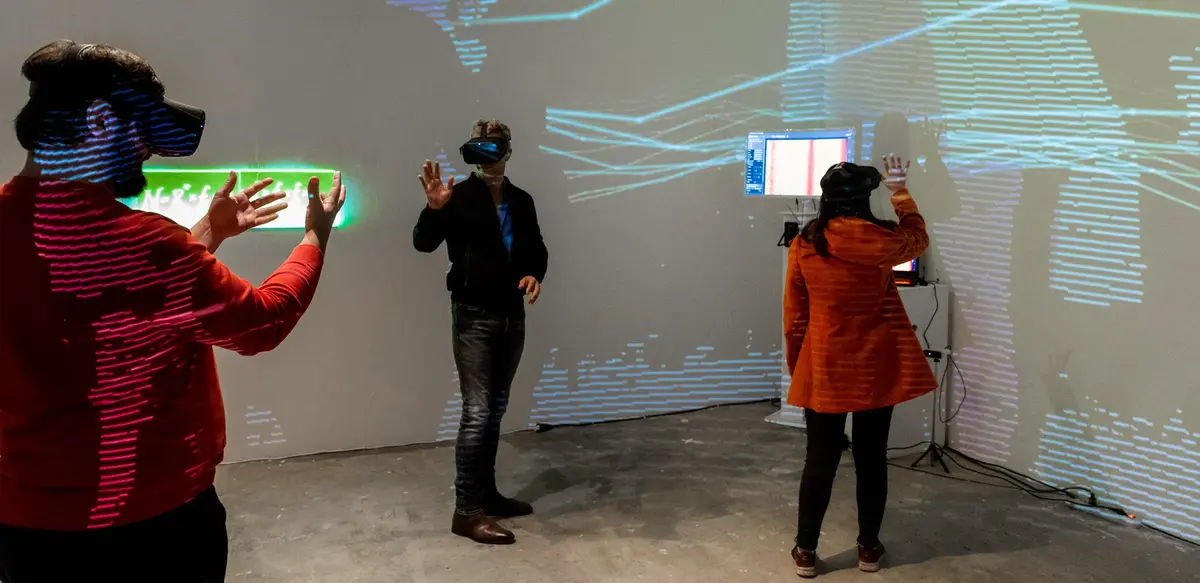
Invisible Universe
project by:
Lauren Moffatt
Kris Pilcher
Seyyed Mohsen Hazrati
The search for life elsewhere in the universe is one of the most compelling aspects of modern science. Given its scientific importance, significant resources are devoted to this young science of astrobiology, ranging from rovers on Mars to telescopic observations of planets orbiting other stars. The discovery of an advanced civilization would likely have profound scientific and philosophical implications, but what does the size and mystery of the universe reveal about the expanse of our inner lives? With this VR proposal, we want to invite visitors into an interactive environment for contemplating the unknowns that exist in the expanse of space and within ourselves as humans.
Upon entering the VR experience, visitors transition into a parse landscape populated by flowers whose heads are artificial radio telescopes. Here, they are surrounded by undulating waves of electromagnetic frequencies which seem to stretch in all directions into Infinity. These waves pulse slowly, changing color and form as they react to the endless data streams returned from various points of
the universe that are being observed by the Charles Allen telescope array. Multiple users exist within the space and can see each other as celestial beings made of light, existing within the ether.
A supplemental interactive video installation is projected onto the wall and ceiling, providing an extra layer visitors outside of the virtual reality component to interact with. These projections are inactive unless a viewer uses a specialized controller fabricated to be a handheld radio telescope. This controller is tracked by a kinect camera. As the viewer scans the controller around the space, the projections react in response. Abstracted visualizations of electromagnetic frequencies are projected momentarily onto the corresponding space. From this perspective the viewer is not only receiving the transmission, but transmitting the data as well. This piece serves to connect users to the exhibition space, outer space, and beam back in to inner space. We are the senders and the receivers.
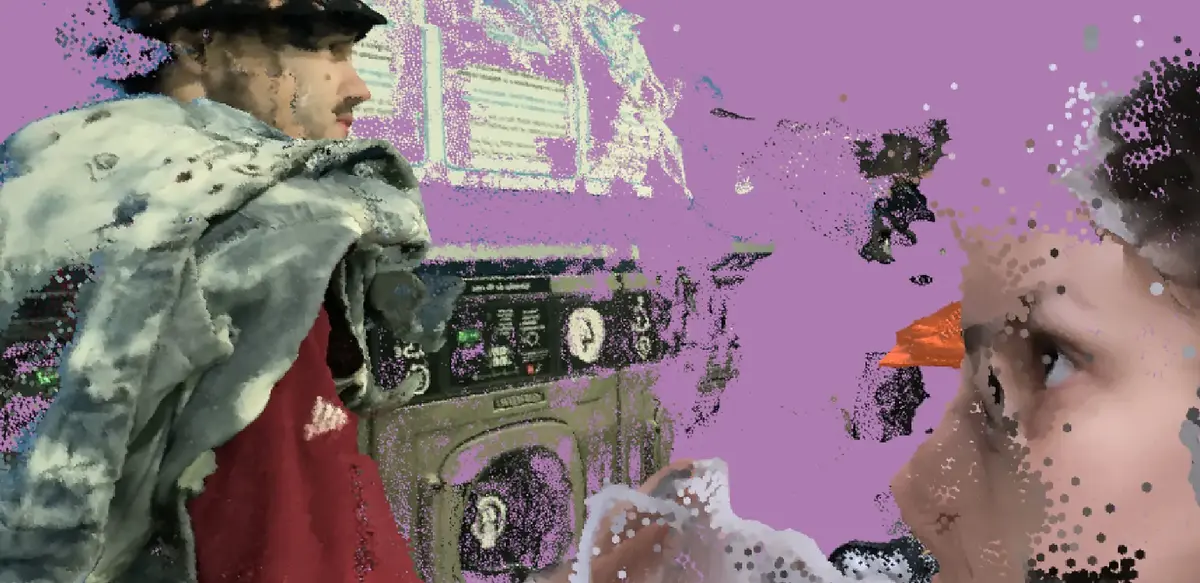
OCCULTATION
project by:
Uwe Brunner
Bettina Katja Lange
Joan Soler-Adillon
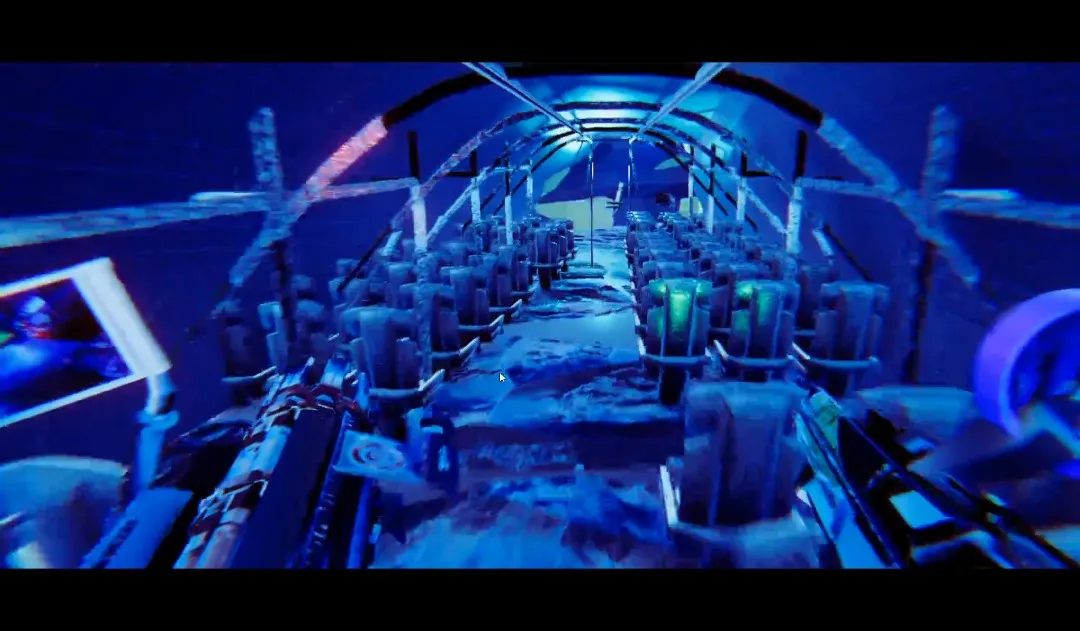
Output:TargetDisplay:Display01
project by:
Mohsen Hazrati
Mohsen will describe his experience of taking part in the residence at Espronceda and of working together with a group of artists for the Immensiva VR/AR Residence 2020.
After this first stage, the covid-19 lockdown in Spain obligated the artist to review his return to Iran and instead keep developing researches and projects in Barcelona.
During the LIVE he will also describe his virtual talk in IAM weekend 2020 RTTT project, which is about reflections and mirrors in the context of the Iranian literature and how RTT technique in 3D game engines could translate this concept into experiences.
Mohsen will also explore the SOKHON art game projects, which is about speech. In this project the player’s voice can alter the game process.
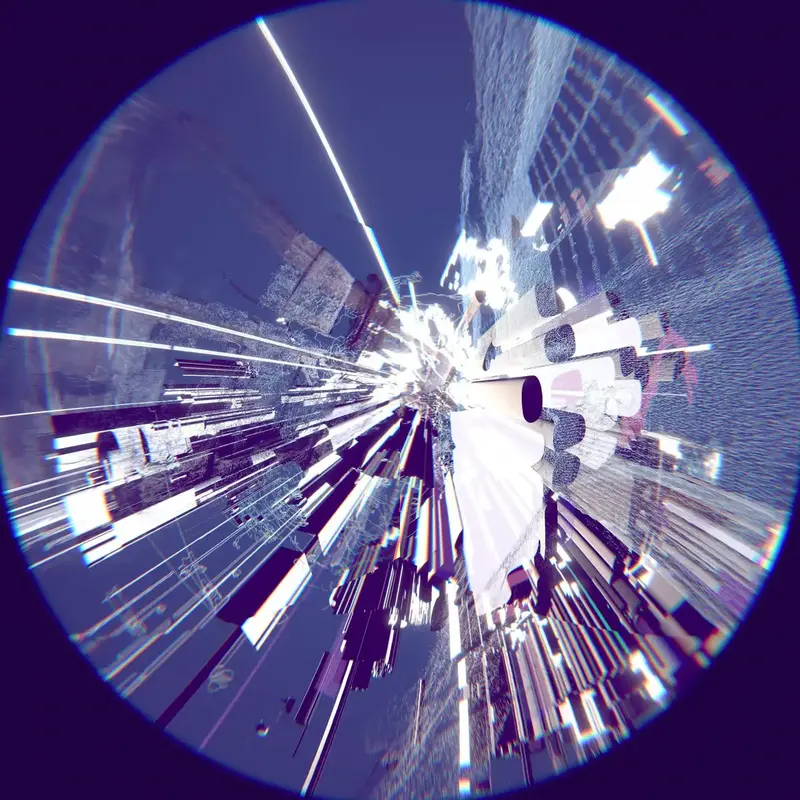
anamníseis
project by:
Ursula Pfligersdorffer
Our memories are fragile parts of the usual forgetting. They create our personality and identity. Letting go of
them is often difficult. In order to preserve memories, we use all the sensory, material, places and techniques that surround us, which also makes a repeated retrieval possible. We instinctively use mnemotechnics (like the locimethod), triggers, hidden affordances and create immobile and mobile places of memory for ourselves. These tools are disappearing in times of digital – global nomadism, so new – old strategies for how we can process, preserve and retrieve memories are needed. The concept of rituals become again more valid in an everyday context. We create ritual cemeteries for our humus of remembrance in order to lay down the memory objects and places on an immersive location to be able to relink our memories at these exemplary places.
The result is a glimpse into an immersive memory string. A journey through a memory about the ocean that shows three connected main aspects of remembring, and the fragmentation through memory loss.
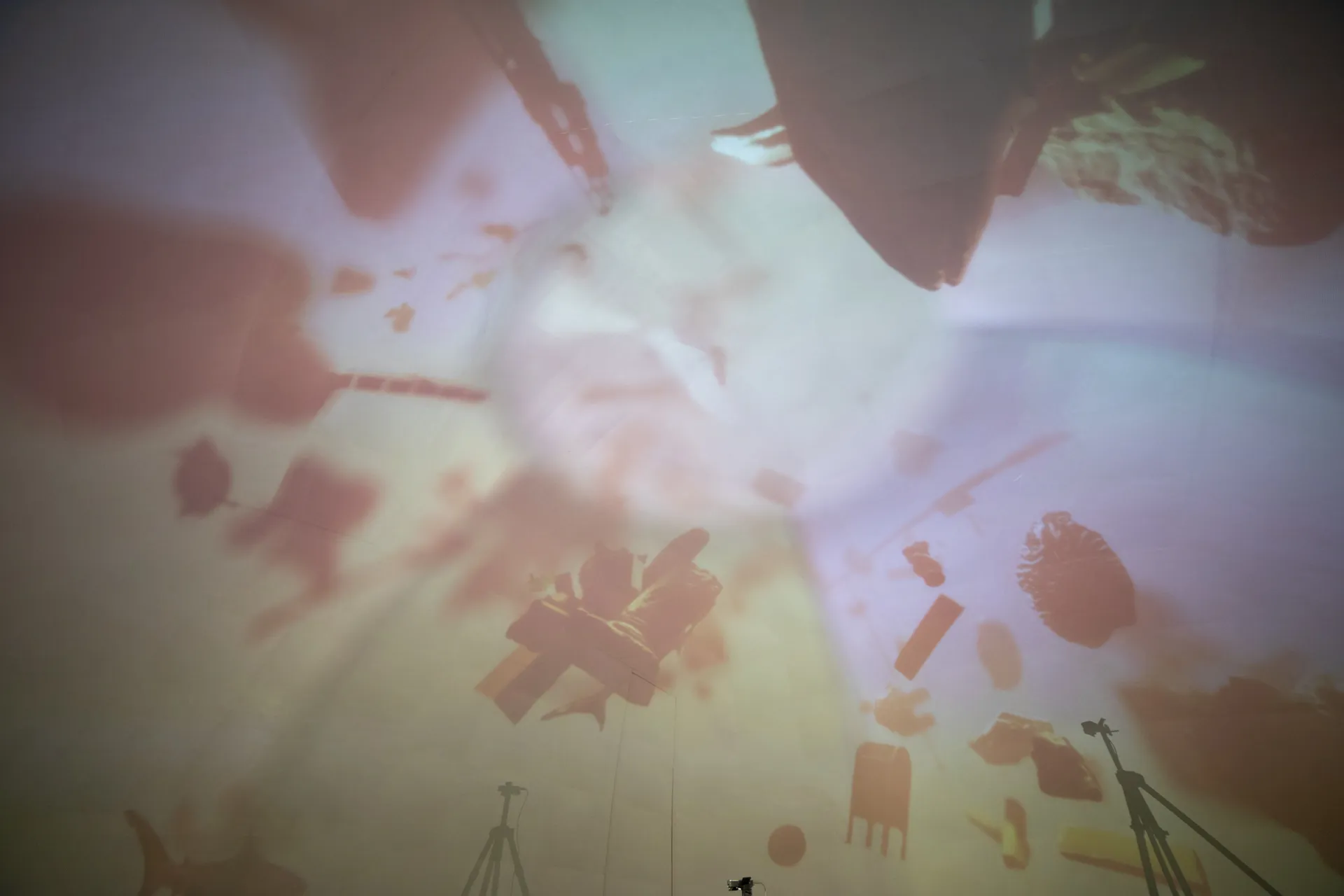
Are You There LUA?
project by:
Anna Pompermaier, Stefan Maier, Martin Romeo
“Are You There LUA?” is a playful, combinatory extended reality installation. It offers the users the unique experience of being, though separated by physical distance, simultaneously present and active in the same phygital environment.
The installation develops as a hybrid, interactive open narrative that explores unconventional communication strategies and brings down the walls of distance and isolation in this time of separation and crisis. The two stations of Barcelona and Milano will let the participants share the same environmental setting. The users will connect over a non-spoken and non-symbolic way of engagement, using their hand, body, and brain as emitter and receiver. The multi-user experience rejects distance, letting participants connect within a shared network of interwoven dependencies – an environmental system, in which one is continuously perpetuating and reproducing the other.
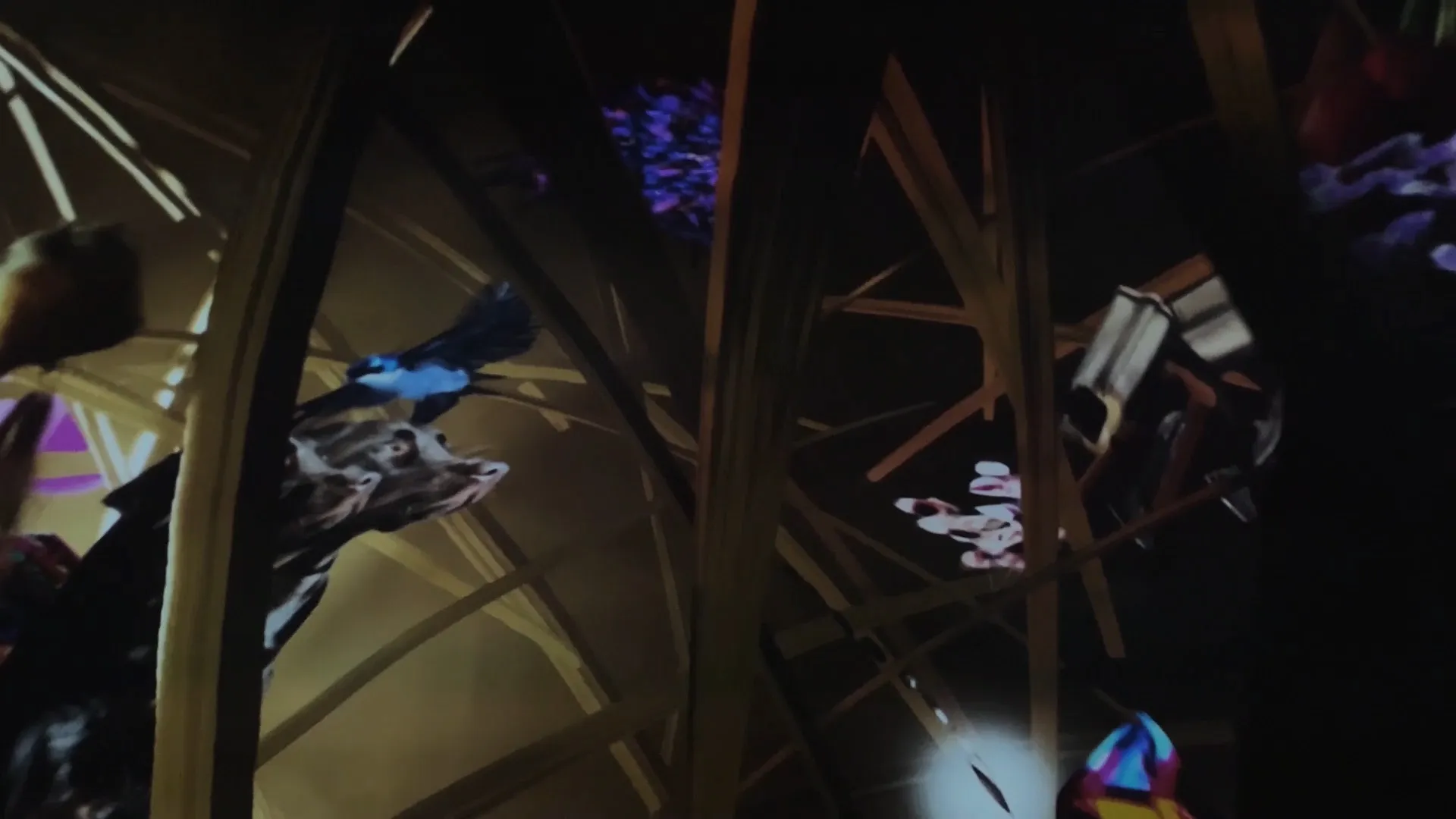
Schrödinger’s Cat
project by:
Raisa Pimentel, Cenk Guzelis, Mohsen Hazrati
Schrödinger’s cat is a thought experiment, sometimes described as a paradox, devised by Austrian-Irish physicist Erwin Schrödinger in 1935.
The scenario presents a hypothetical cat that may be simultaneously both alive and dead, a state known as a quantum superposition. The Copenhagen interpretation of quantum physics, which was the prevailing theory at the time, proposed that atoms or photons exist in multiple states that correspond with different possible outcomes and the possibilities , called superpositions, do not commit to a definite state until they are observed.
The cat will be both dead and alive until someone looks in the box. In quantum mechanics lingo, the cat’s ability to be both alive and dead until it is observed is referred to as quantum indeterminacy or the observer’s paradox. The logic behind the observer’s paradox is the proven ability of observation to influence outcomes.
The cat is both alive and dead. In this interpretation, the observer and the cat simply exist in two realities — one in which the cat is dead, and one in which the cat is alive.
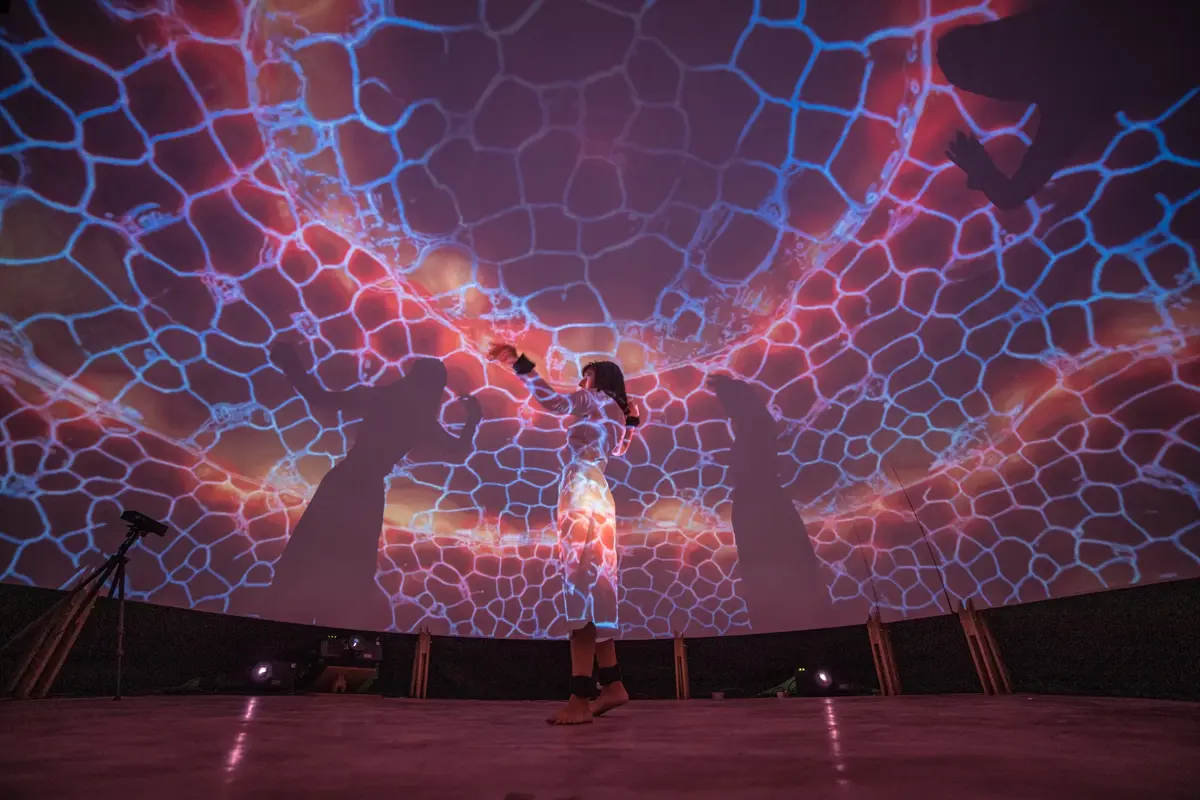
Wonders
project by:
Moon Ribas, Felix Schoeller and Ferran Belda
WONDERS is a journey across natural phenomena beyond human perception aiming to generate primordial aesthetic emotions such as wonder, admiration, awe, and the sublime. Pioneer cyborg artist Moon Ribas is equipped with a system of sensors and actuators allowing her to translate natural events into movement. These events are detected either in real-time or the very day of the performance by scientific instruments across the globe. As such they serve as a score for the performer to embody earthquakes, volcanic eruptions, and cosmic explosions. A system of wearable sensors developed by Felix Schoeller captures Moon Ribas’ gestures and transforms them into sounds, which modulate Ferran Belda’s interactive visuals projected on the surface of the dome. At the interface of performance, augmented
reality, creative coding, and storytelling, WONDERS aims to generate primitive peak emotions, and remind the audience, sitting in a circle around the performer, of the fragility of human constructions and vastness of the cosmos.
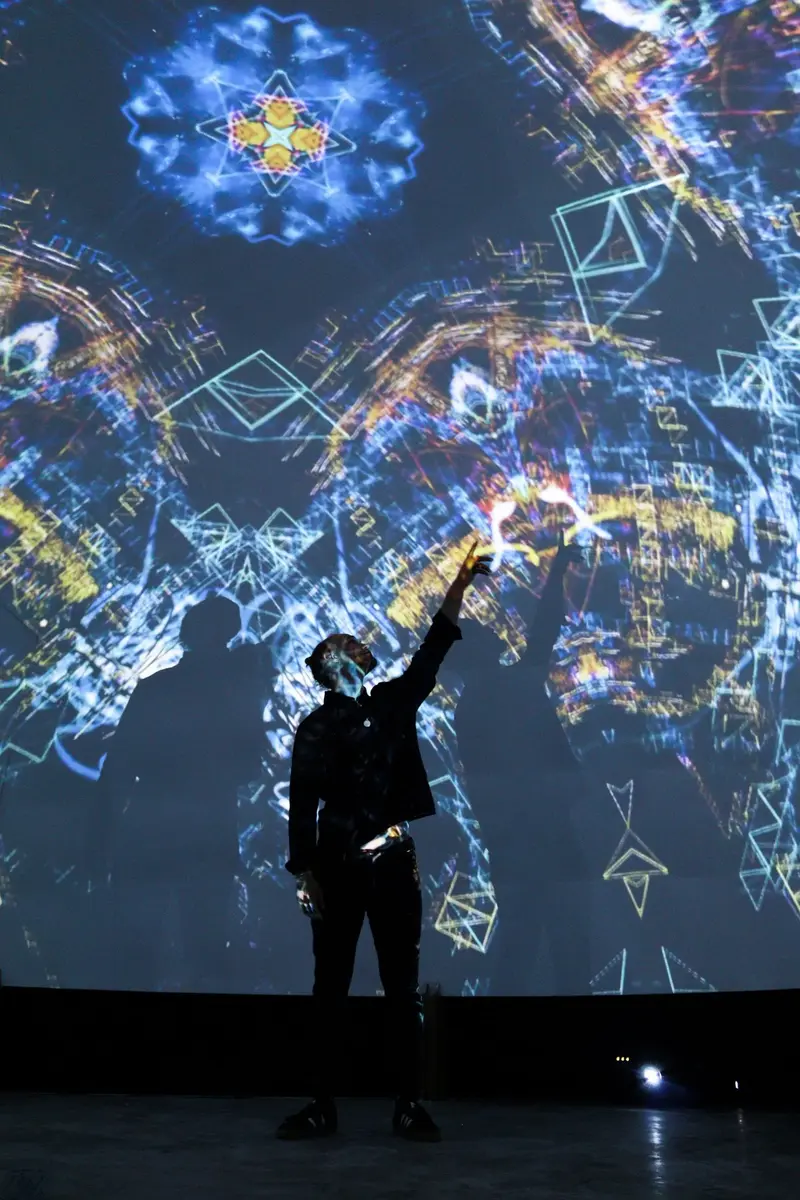
Dome the Portal - Inside your soul
project by: Ovidiu Valeriu Bojor
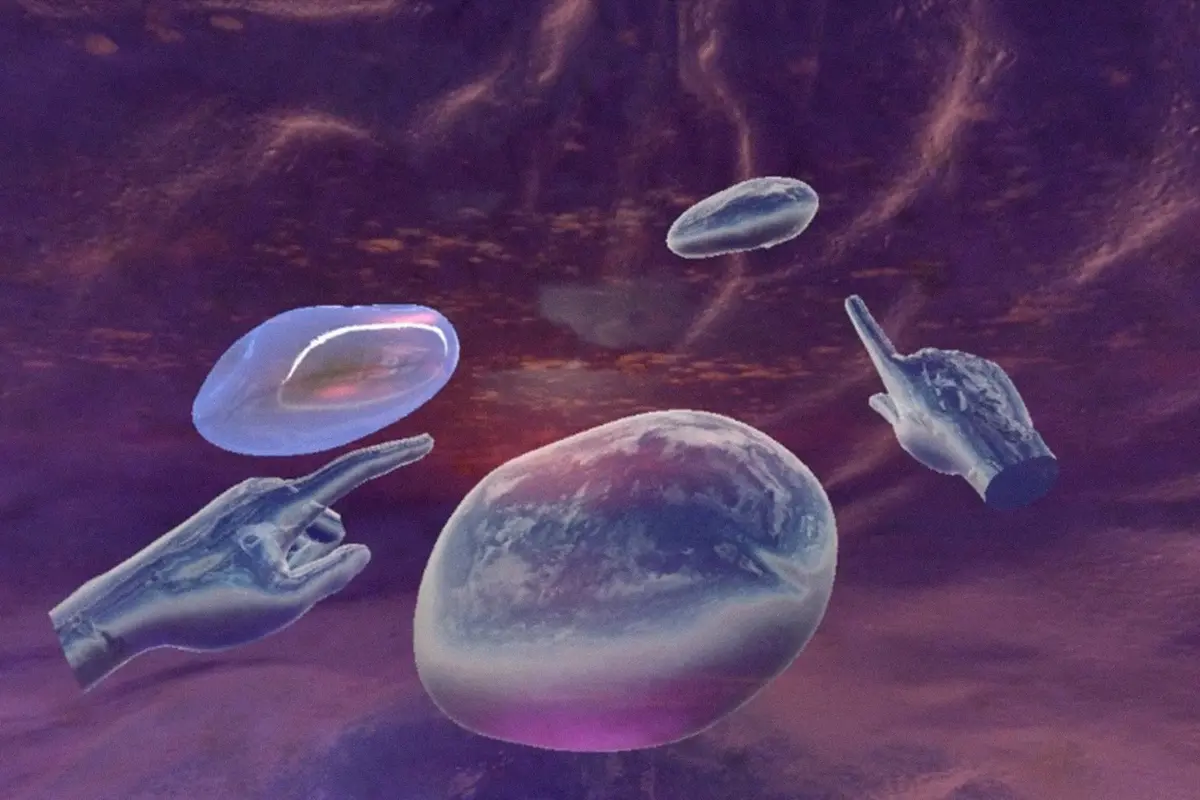
OXYTOCINA MACHINA
project by:
Sammie de Vries, Mila Moleman, Zalán Szakács, Lucía Redondo, Mathieu Preux
It is a common misconception that virtual reality isolates us from one another and the world, so Studio VRij, Zalán Szakács and Immseniva joined forces to prove otherwise.
Oxitocina Machina is an extraordinary shared experience that blurs the lines between reality and VR, exploring a virtual connection between strangers, who are in reality separated by a thousand miles. During the experience people who have never met develop a deep connection and release the love hormone oxytocin by playing, moving and sharing.



OXYTOCINA MACHINA
project by:
Sammie de Vries, Mila Moleman, Zalán Szakács, Lucía Redondo, Mathieu Preux
It is a common misconception that virtual reality isolates us from one another and the world, so Studio VRij, Zalán Szakács and Immseniva joined forces to prove otherwise.
Oxitocina Machina is an extraordinary shared experience that blurs the lines between reality and VR, exploring a virtual connection between strangers, who are in reality separated by a thousand miles. During the experience people who have never met develop a deep connection and release the love hormone oxytocin by playing, moving and sharing.
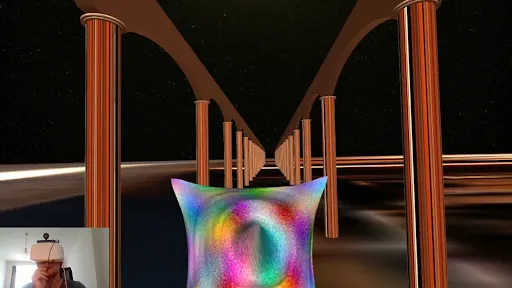

XHALE
project by:
Dilara Başköylü, Egemen Ertuğrul.
They propose a new interface for human-computer interactions that allows for respiratory actions. Our method aims to use commercially available microphones to detect inhalation and exhalation. actions through real-time sound processing and AI. We wish to map the detected expressions to different parameters in virtual and XR environments, for meditation, stress relief, relaxation and awareness. His method can become a multi-user experience to form a strong sense of harmony.
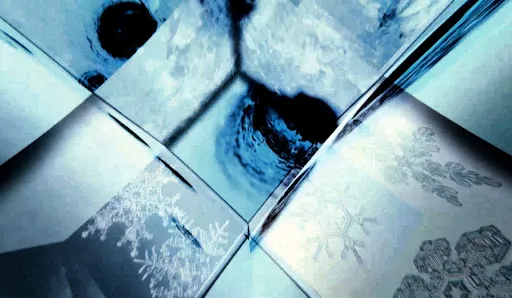

TesserIce
project by:
Jared Christopher Kelley, Max Orozco, Clea T. White
Climate change is a defining issue of our time. How can we comprehend the recession of a glacier that
progresses over three generations or the slowing of an oceanic current? Ice cores drilled from glaciers in
Greenland and Antarctica provide a view 800,000 years back into the history of Earth’s climate.
TesserIce is a four-dimensional, VR mediascape that allows one to enter the space-time of glacial ice. It is a
hyper-documentary poem examining the effects of climate change on polar ice from within 4D space.
The participant enters a crystalline tesseract composed of different scales, forms, sounds, and speeds of ice.
Their movements propel them through the hyper dimensions of this tesseract as it unfolds in unchartered
vistas, juxtapositions, and timeframes – the 4D space-time of Earth’s polar ice. TesserIce brings the human
into the space-time of glaciers, creating an embodied experience of the time, scale, causes, and effects of
climate change.
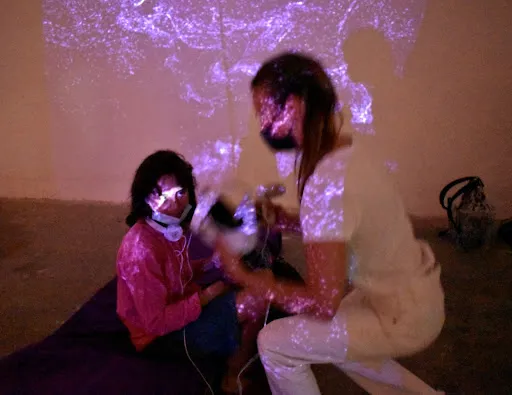

SCIENCE OF HAPPINESS: Breath and Color
project by:
Dr. Bojana Ginn i Pekko Vasantola
The healing properties of meditation and slow breathing, as well as the meaning of color, have been known to mankind for thousands of years. Recently confirmed by science, specific breathing and color frequencies produce a feeling of relaxation, well-being and healing, even at the cellular level. Leveraging the science of happiness, the immersive video-acoustic installation gently guides visitors toward synchronization with these healing rhythms.
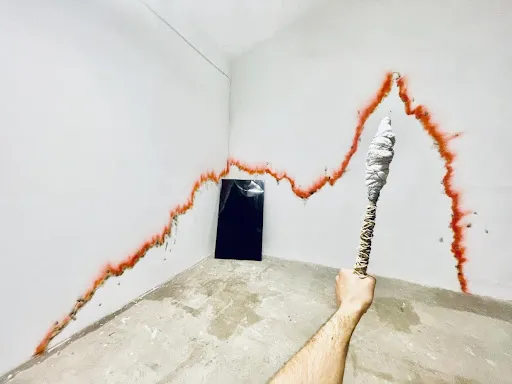

VIMANA
project by:
Emanuele Dainotti, Commonolithic, Sara Tirelli, Racelar Ho, Nicoletta Favari, Christopher Salvito, Guilherme Martins.
It is a 6DoF interactive immersive installation that opens up the possibility of creating new forms of rituals that exist between the real and the virtual. The key element that defines the existence of each participant in this virtual world is a torch that they carry with them and that will be passed from hand to hand, as a user.
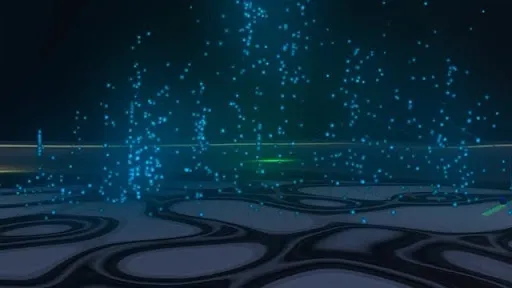

NONLINEAR LINEAR CASUALITY
project by:
Álvaro Muñozledo, Mathieu Preux, Sofia Beatrice Malatesta
«Nonlinear Causality» is an interactive immersive installation that questions the boundaries between the physical and the virtual. Through actions, the audience generates nonlinear consequences that have a greater impact on the virtual environment and vice versa. Here, art and technology are modeled on each other to generate an experience that resonates in personal and social responsibility, digital awareness, and the ability to act as an active catalyst and passive audience.
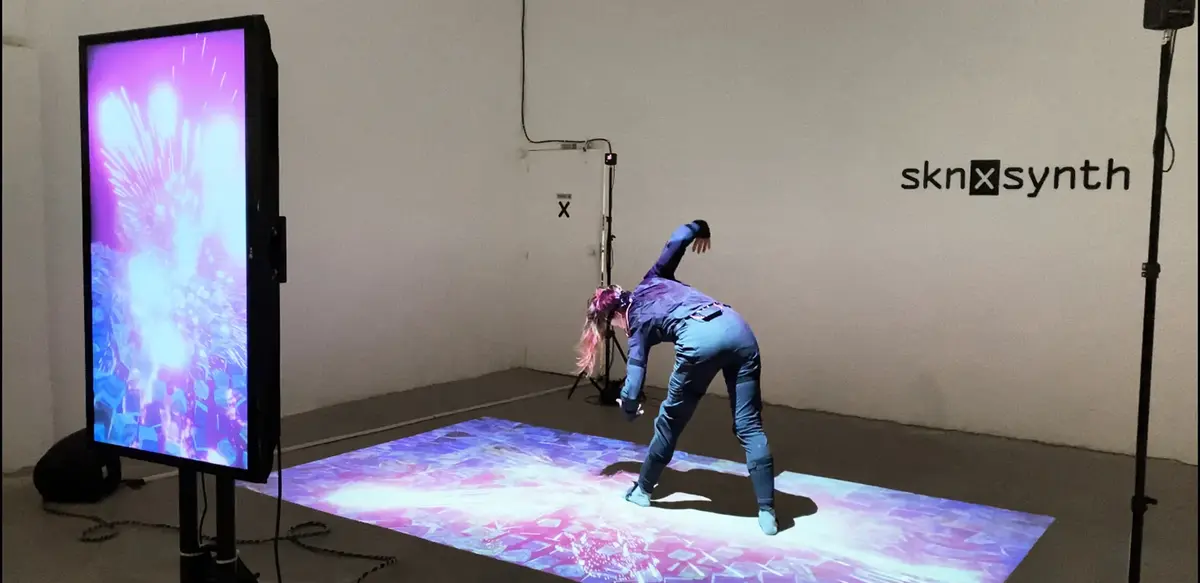

SKNXSYTNH A xenotransplantative skin
project by:
Cenk Guzelis
Seyyed Mohsen Hazrati
Josecarlos Florez
PROUD TO BE FLESHED or DESIRED TO BE WIRED ?
Where does the body start and end ? Are we limited to our biological skins? What is the skin of the self in virtual ? Can we interface with non human beings to define another sense of self ? How to develop a new perception of flesh and materiality?
What is the value of manipulating and estranging bodily awareness?
The xenotransplantative skin project acts as a new layer of skin that interfaces virtual and biological bodies to create sensual friction, construction of a self image through detachments from bodily self and a space of negotiation between the self and the other that expands and oscillates between virtual and physical. We are focusing on performative scenarios evolving in types of digital species. Through an immersive, virtual and physical installation the self acts as a real and metaphoric interface between bodies and worlds in transition.
During the experience the virtual space becomes a mysteriously unpredictable parallel world in an area between deceiving spatial perception, acoustic hallucinations. The installation is going to be experienced between the virtual and the physical, looking at the world not as physical versus digital objects but rather both entangling, both leaving residue of parts behind thus shaping one another, forging a new type of relationship between parts and wholes, involving one’s own body as a site of production and enabling imagination to travel to new statuses, combinations and hybrid formations.
The Interactive Installation considers the physical specificity of the body’s experience to the design of ‘more fluid’ human-computer interaction environments via real time capturing devices such as motion tracking suit that acts as a mediator between realities. The performative Installation hosts a performance artist whose motion is captured and transferred in realtime to the virtual environment. The performance of the artist behaves as a granular synthesizer. Her motions will be controlling the parameters
of a granular synth which will create the 3D visuals of her virtual body. The Installation will be displayed with a floor projection and a large TV screen that can be positioned anywhere in the room which opens up to a virtual dimension.
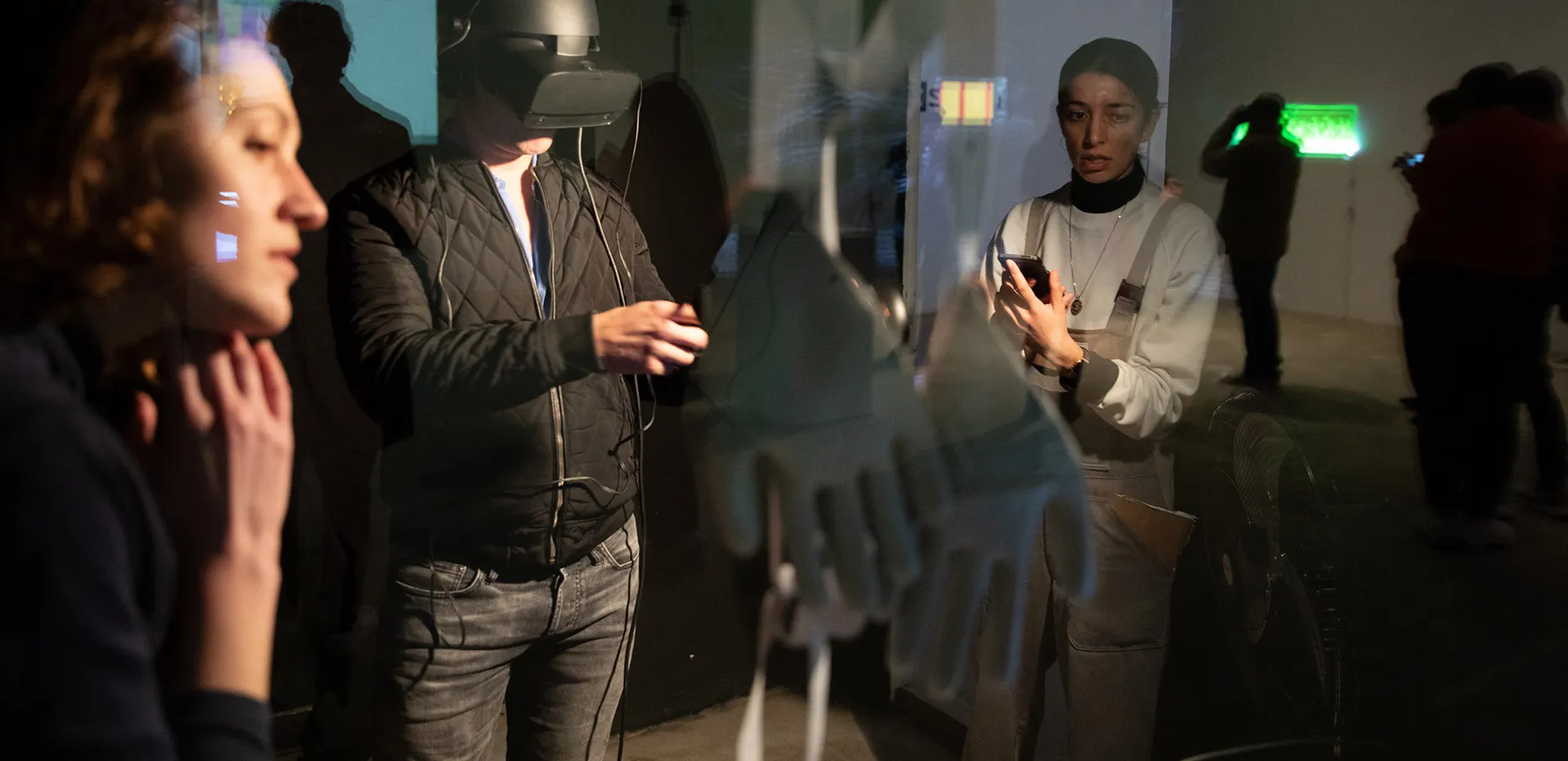

FRICTIONAL FORCES
project by:
Clarice Hilton
Shivani Hassard
Frictional Forces is a training tool to help you connect to the body.
Between your morning Deliveroo and your brain games in your Uber to work, consider getting your daily dose of physical frustration.
Physical effort has been completely eliminated from certain able-bodied groups’ experience of daily life, relegated to a quaint memory, the business of those on the margins. Frictional Forces is a system to counteract the seductive numbing that comes with technologies of convenience.
Frictional Forces is a stretching class for the squeezed middle, for whom it is taken for granted that life is getting better through ‘self-optimisation’. In fact, their every movement is digitised, leaves behind a data dust cloud, gobbled up for further training. The convenience of personalisation brought by data surveillance has left their bodies seeming like hotels, foreign and almost irrelevant.
Here, we present a prototype of the project. We are building towards a room scale interactive installation that combines immersive theatre with speculative design, creating a conversation between virtual and physical spaces that explores the way that technology mediates our perceptions and shapes our behaviour.
Through narrative, VR’s sensorial eclipsing and centering the audience’s physical interaction with technology, we aim to subvert the frictionlessness of immersion in virtual worlds.
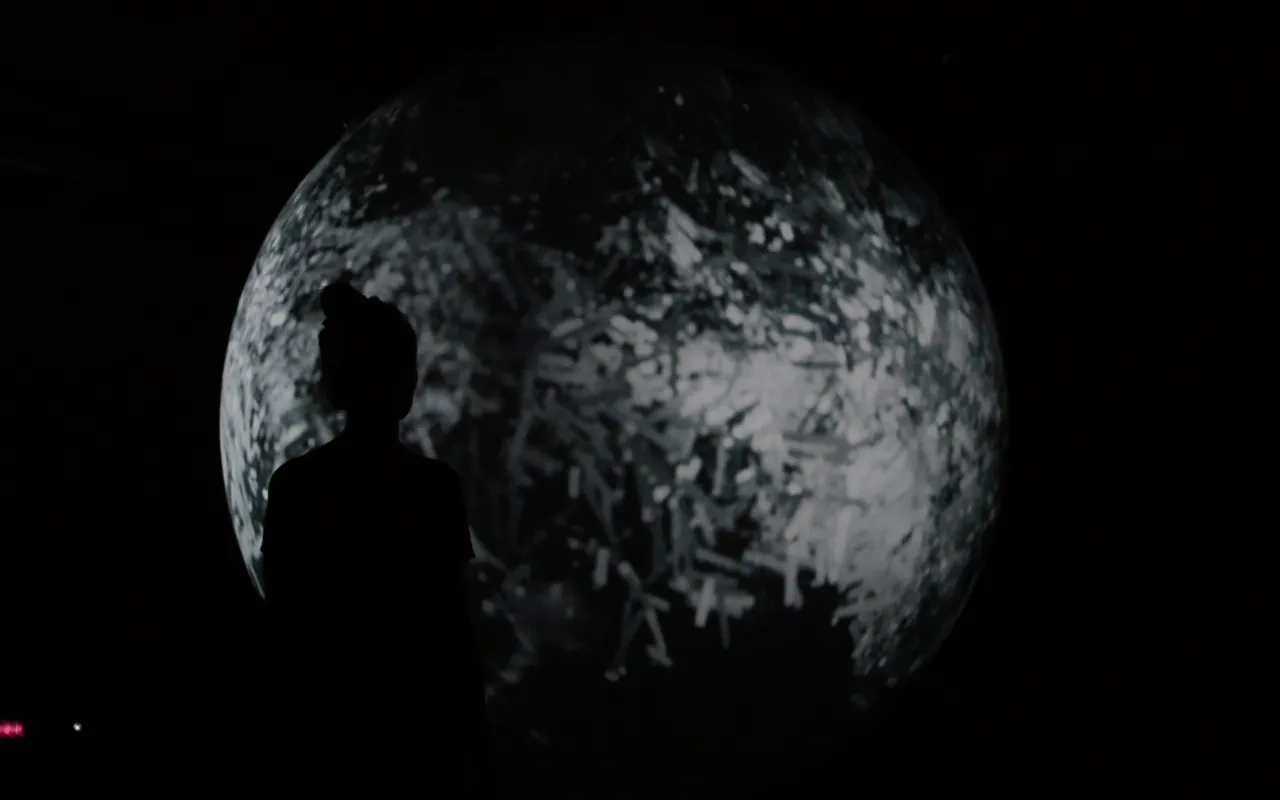

ABVXHMN Above Human / epidemic-spheres
project by:
Anna Pompermaier, Cenk Güzelis, Burkart Schwaighofer
The pandemic generates a diffuse feeling of affiliation. China-Japan – USA – South Korea – Thailand – Vietnam – Nepal – Singapore – Taiwan – Australia – Iran – Turkey – Italy – Germany – Austria – Great Britain – Norway – Spain – Iceland – Brazil – Peru … The virus spreads, take territories, and leave traces. It pulsates, vibrates, interacts in and with the various spheres: private-sphere, public-sphere, economic-sphere, techno-capital sphere, info-sphere, psycho-sphere. It is already post-digital if we consider it «Being global, Being big and small, Being prime, Being equal, Being unterritorial».
ABVXHMN is an interactive projection mapping installation that displays the real-time data of COVID-19 inside an epidemic-sphere. It makes the invisible visible, the immaterial material. It is not just an audio-visual experience, but rather an active and communicative act: the global outside flows into the local inside and merges into a space of coexistence. In line with Peter Sloterdijk, the «sphere» becomes a symbol for «spaces of coexistence» as spaces that deal with crucial information to develop a better understanding of humanity. When visiting the ABVXHMN installation, the encapsulated spherical entity of the virus occupies the human body via tracking cameras to display its existence
An Interactive Spherical Projection Mapping Installation
Text: Marco Russo
Voice Over: Will Stafford
Sound Design: YAMAN, Kristaps Austers
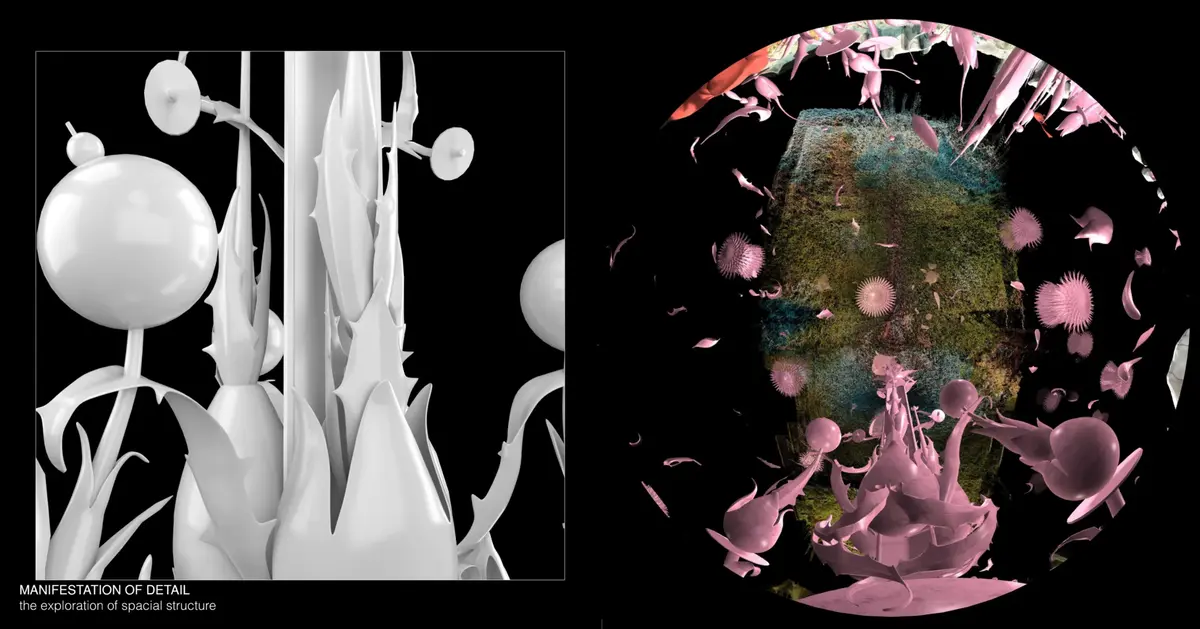

Hieronymus Garden Of Digital Delight
project by:
Lukas Kochendörfer
Hieronymus Garden Of Digital Delight – interpretations of agis, works with the beauty and complexity of Hieronymus Bosche’s most know work, The Garden Of Earthly Delights. A triphtych painted as a parallel world bound to sphere, that had people emerge in it for centuries as well as beeing a major well of inspiration for Salvator Dalí and the expressionist movement.
The installation is a dome specific experience and in relation to that, the painting was chosen. It having an omnipresent topic of spheres and circular spaces within a main sphere itself as well as the attached narrative of being watched and gazed upon on it from the outside. Needless to mention its scenery being strongly immersive in essence.
By depicting the the Garden of Earthly Delights into layers of percetion, the full dome experience manages to create an spatial journey into abstracted sceneries of the painting connected to its initial narrative. It highlights parts of the painting whilst translating them into the medium of the digital.
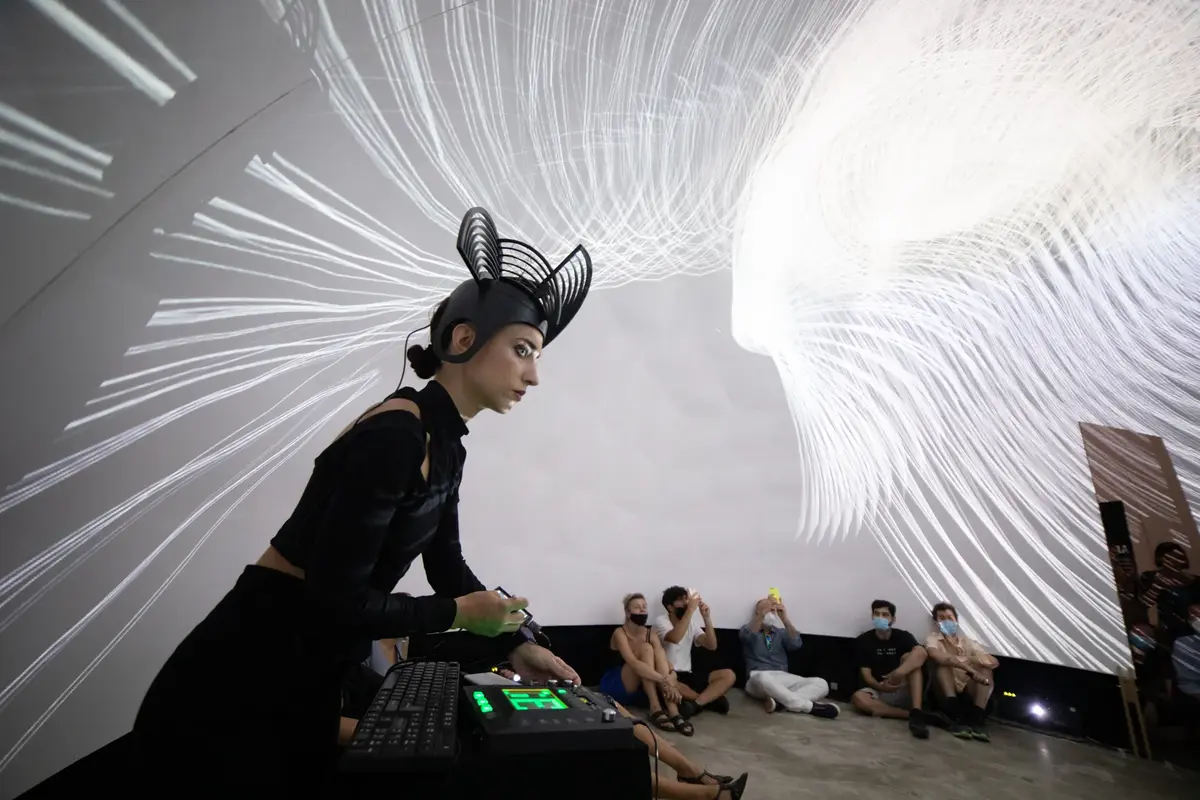

Spectrum
project by:
Agustina Palazzo, Radiorator Project with Betiana Pavón and Mateus Sartori & VPM collective: Joan Nieto and Javier Cañal.
Spectrum is an Audio/Visual live performance result from the first collaboration between Agustina Palazzo and
VPM collective. Aims to represent the invisible energy that surrounds us, more specifically the artificial and invisible
energy of information and communication transmitted through radio frequencies.
The project mixes Agustina’s recent collaborative project, Radiorator with interactive live visuals of VPM. Radiorator is a performance of sound experimentation, that results from the expanded perception generated by capturing radio frequencies with a digitally designed and manufactured technology helmet.
The wearable works as a portable device, with an antenna and an specific software installed that allows listening to the broad spectrum of radio frequencies. During the performance, Agustina captures radiofrecuencies and processes them in real-time to generate a sound composition. The audience will be in an immersive and multimedia experience of the electromagnetic energy that is around, demonstrating that there are so many artificial artifacts affecting us and our surroundings.
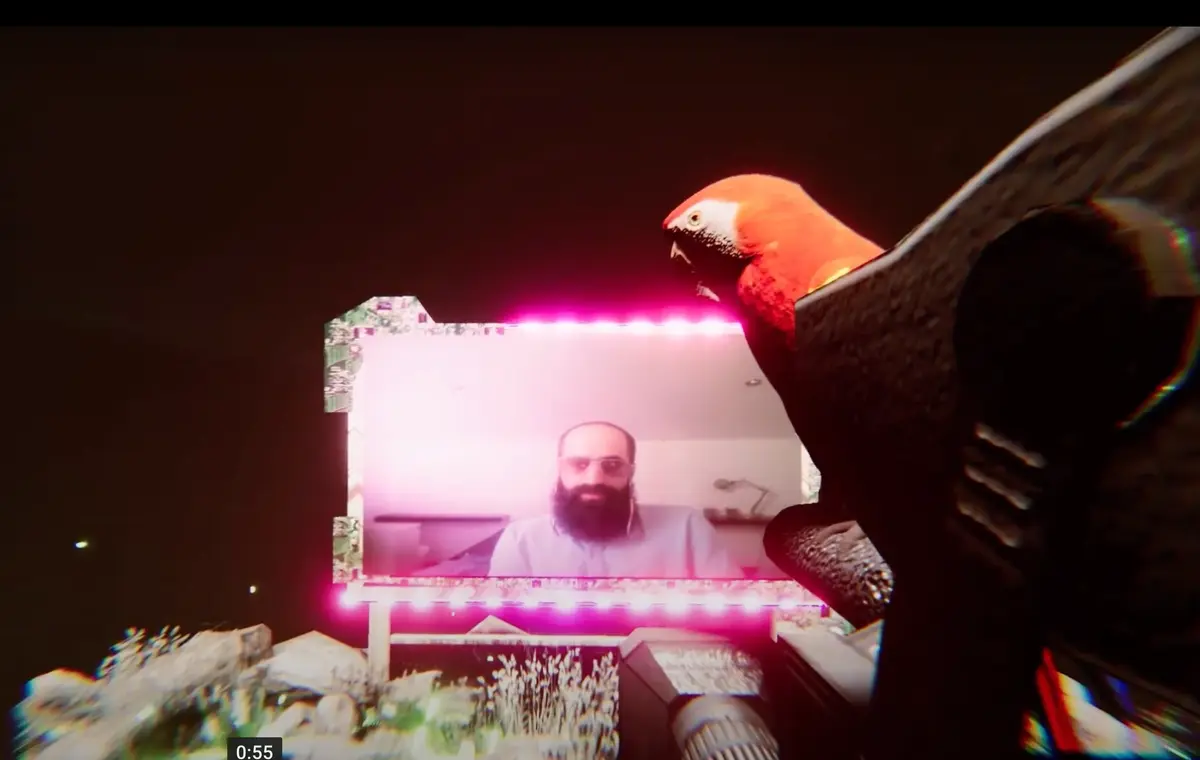

RTTT
project by:
Mohsen Hazrati
This project is about reflections and mirrors in the context of the Iranian literature and how RTT technique in 3D game engines could translate this concept into experiences.
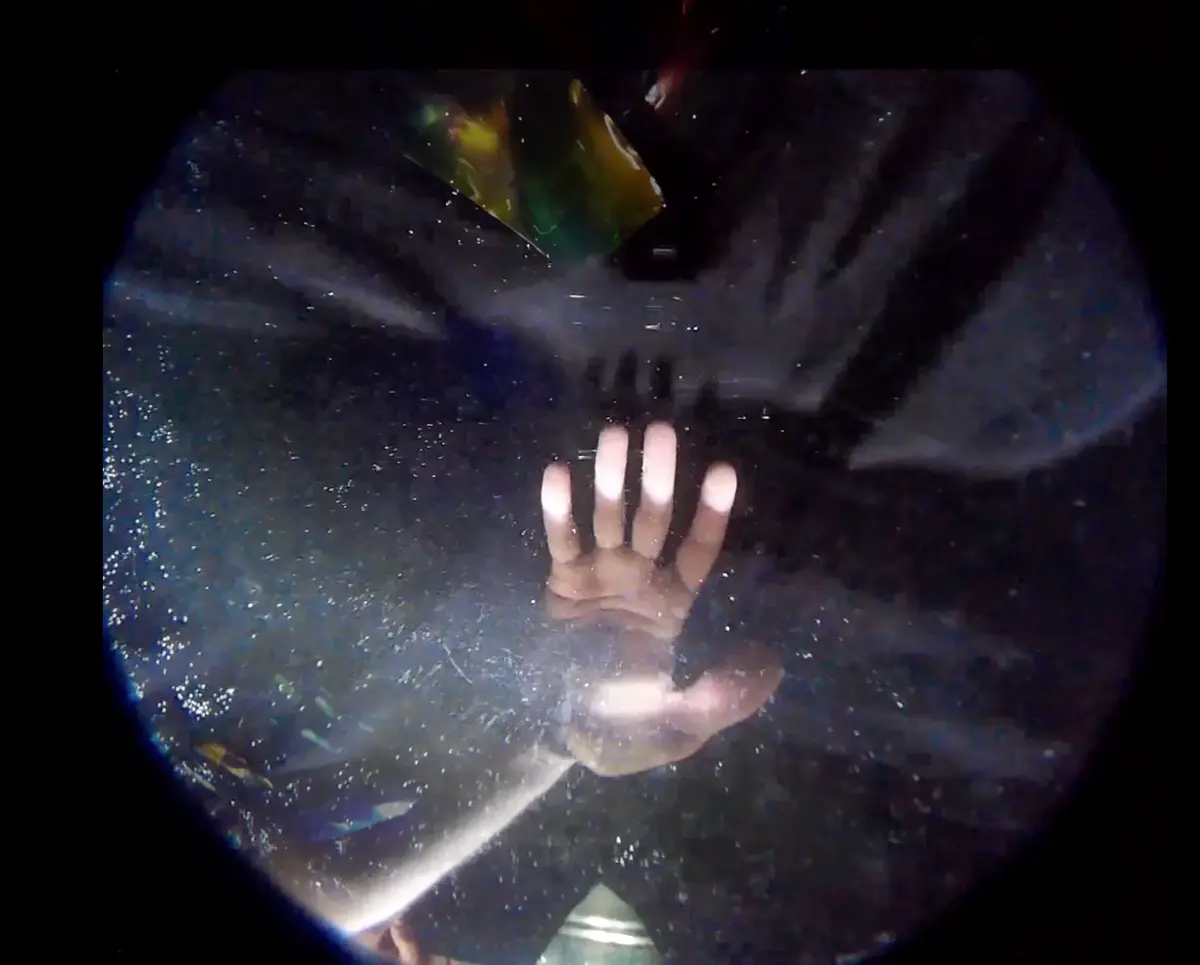

Golden microcosmos
project by: Raisa Pimentel, Anja Calas and Agustina Palazzo
Starting from the assumption that all living and non-living things have some form of energy and electricity, our proposal is to make it visible and tangible by connecting a experimental visuals built for dome experience with biofeedback input that will translate our vision in an attempt to transcend our perception, reflecting the beauty of the (micro)cosmos and adding it’s physical (dis)order. In a poetic almost abstract act, we are going to listen, feel, see the aura, our consciousness, feel the frequency in which we vibrate and experience an audiovisual Dome story, of simple “balms for sore souls”. Humans conduct biofeedback naturally all the time, at varying levels of consciousness and intentionality. Every human being is a microcosmos within himself. It is a universe of cells, each with its own individual intelligence. The health of our cells depends on the vibrations it receives from us in the form of thoughts, emotions and feelings. It is understandable that the body is a complex waveform, and that it is the sum of many smaller waves or vibrations, which originally began with a frequency so in balance that it unleashed everything that we believe to be, even if it is inconsistent within a virtual consistency. The sound will be the result of the sourced biodata from skin conductance sensors. The video will be an exercise of the imagination of what our electrical bodies touch, image-wise in other words if each one of us could emanate a visible field what would that be like?
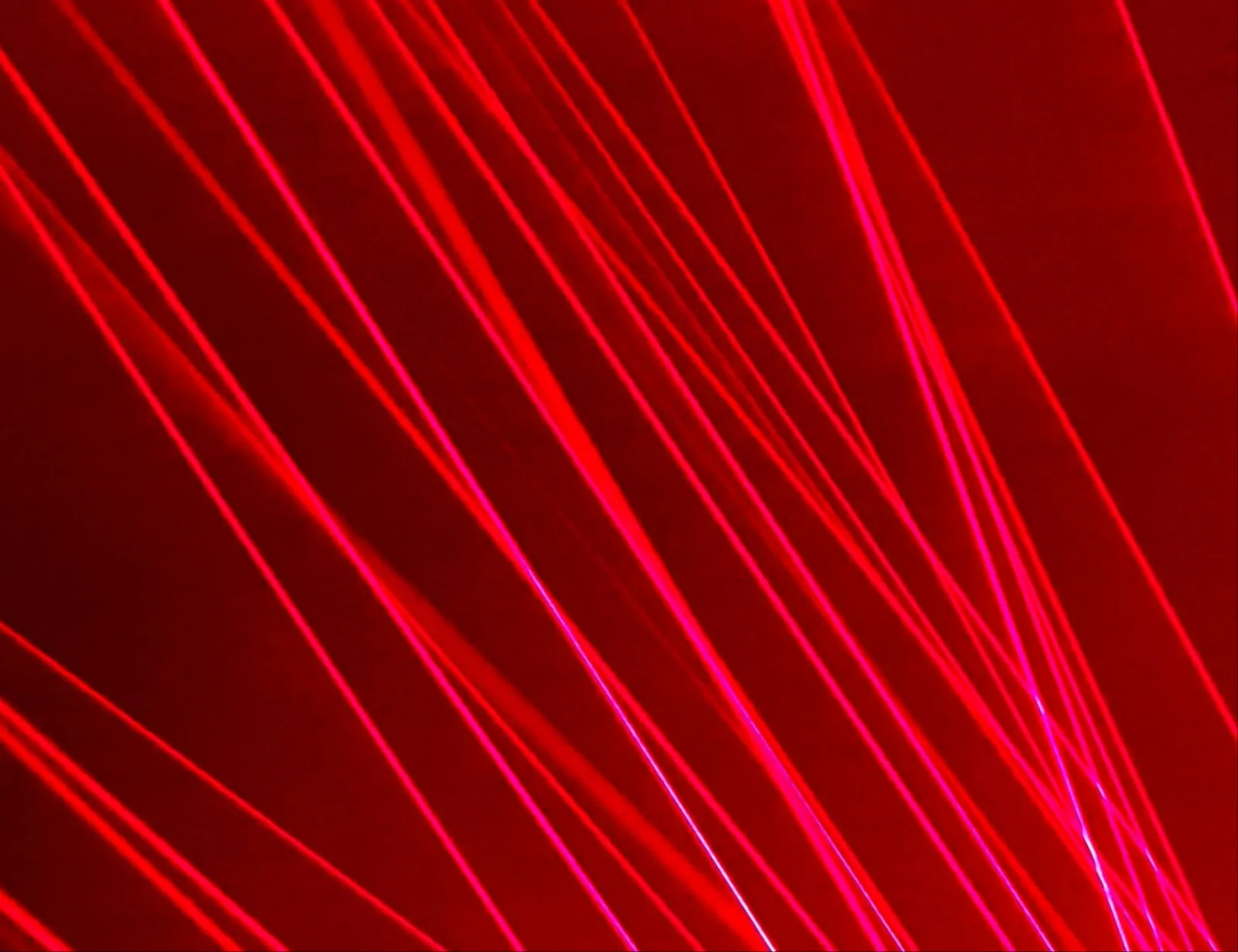

ELEMENTS
project by:
Ferran Belda
ELEMENTS is an audiovisual immersive performance that explores about the perception of the environment and the creation of three-dimensional shapes using projected light beams and lasers.
The performance was presented for the first time during the Quintessence dome Lab residency.
